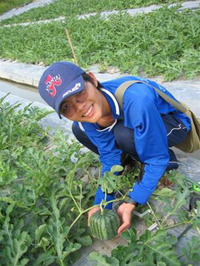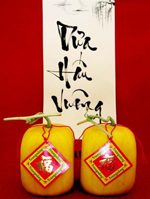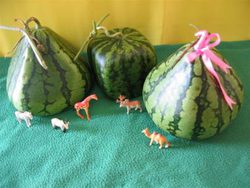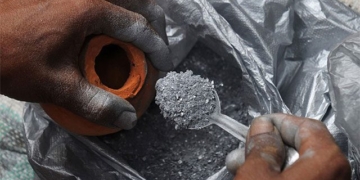 |
|
Dinh Tran Nguyen by the square watermelon patch (Photo: TTO) |
Dinh Tran Nguyen is the son of agricultural engineer Dinh Cong Muoi and Dr. Tran Thi Ba. He is a second-year student in the crop growing department at Can Tho University. During the Year of the Dog (Binh Tuat), Nguyen successfully created square and pyramid-shaped watermelons, marking a breakthrough in the watermelon cultivation industry for the Lunar New Year and export.
This is a new type of fruit produced in Japan, selling for up to 80 USD each; in Vietnam, Nguyen’s new watermelon variety is priced at 500,000 VND per pair.
The Idea Behind the Square Watermelon
In 2004, a television program introduced the square watermelon in Japan. Hearing many discussions about it, I became intrigued by the topic. Later, while browsing the Can Tho University website, I unexpectedly found a forum titled “Square Watermelon” on December 13, 2004! The forum was initiated by Vice Principal Do Van Xe, with many teachers from both domestic and international backgrounds participating. Some claimed it was a product of genetic engineering.
Professor Duong Minh (Department of Agriculture and Biotechnology) asserted that the Japanese had shaped the watermelons using molds! Others insisted that if square watermelons truly existed, they would buy them for the New Year celebrations, regardless of the price. In Vietnam, no research had been published on producing square watermelons, nor had any artisans been reported to have created them. The only practice was carving designs on regular watermelons for decoration during the three-day New Year period.
 |
| Photo: TTO |
From that moment, I began searching the Internet for everything related to square watermelons worldwide. However, I only found a few images of square watermelons selling for 80 USD each in Japan, with absolutely no technical information available about them.
I discussed this with my parents, who were very supportive. I boldly decided to experiment with square watermelons during the 2005 Lunar New Year. Unfortunately, this attempt was not successful. The several million VND that my parents allocated for the experiment… went to waste! Out of 30 initial fruit, I could only harvest four, and they were tiny, measuring less than 14 cm on each side.
Fortunately, after the New Year, around March 2005, Can Tho University announced funding for students to conduct scientific research. It seemed luck was on my side; I boldly registered a project titled “Research on Technical Measures for Producing Square and Pyramid-Shaped Watermelons for Lunar New Year Decoration.”
I didn’t know if my proposal would be approved, but I continued my experiments with various methods, driven by a strong determination. By July 2005, the university announced that I would receive a grant of 5 million VND for my research. I rushed to purchase mold materials, sought farmers for collaboration, and monitored the daily growth of the watermelons to appropriately fit them into the molds…
Results
 |
|
Photo: TTO |
During the Year of the Dog, I produced 14 watermelons from the initial batch of 50. The technical challenges were significant due to side effects that occurred when the watermelons were placed into… “isolation”!
This explains why watermelons produced in Japan are sold for 80 USD. I took them to Xuân Khánh Market in Can Tho City to sell them just before the New Year. A pair sold for 500,000 VND, and there were still buyers. For the last pair, someone was willing to pay up to 650,000 VND, but I hesitated to sell it for fear of losing the seed variety!
According to my research agreement with Can Tho University, by July 2006, I will transfer the entire production process. I hope by then to improve the process to achieve higher yields and make it widely available.
BAO DIEN


















































